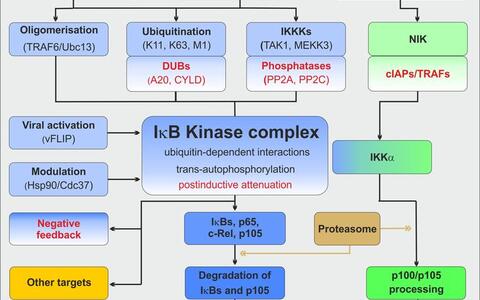
Introduction to NF-kappaB
The mammalian NF-κB family comprises five related members, p50, p52, p65, c-Rel and RelB, which form distinct hetero- and homodimers and regulate hundreds of genes in the context of multiple important physiological and pathological processes. The inhibitory IκB proteins, e.g. the cytoplasmic IκBα or the nuclear Bcl-3 and IκB-ζ, have been discovered as fundamental regulators NF-κB activity. As a characteristic feature of NF-κB, two of its subunits, p50 and p52, are generated by proteasomal processing of their precursor proteins, p105 and p100, respectively.
NF-κB activation requires the IκB kinase (IKK) complex, which is composed of two serine-threonine kinases (IKKα and IKKβ) and the regulatory subunit NEMO (also known as IKKγ). The IKK complex is a signal integration hub, which sequesters a wide variety of extra and intracellular signals to catalyze phosphorylation of various IκB and NF-κB proteins as well as of other substrates. Distinct signaling pathways, activating specific NF-κB family members, can be distinguished (see Figure).
Canonical signaling cascades occur in a rather rapid fashion and can be activated by various cell-surface and intracellular receptors. A characteristic feature is the formation of K63-linked and linear polyubiquitin chains at TRAF or RIP proteins, which mediate recruitment of regulatory protein complex. Finally, IKK becomes activated at its kinase activation loop serines. Catalytic active IKK complexes trigger degradation of IκBs and liberation of prototypic p50-p65. Negative feedback regulation of canonical signaling pathways is provided by NF-κB dependent expression of IκBα and deubiquitinating enzymes such as A20 or CYLD.
The non-canonical NF-κB pathway is activated by a specific set of receptors and induces C-terminal processing of NF-κB2/p100, thereby allowing the nuclear translocation of p52-RelB. The non-canonical pathway proceeds with much slower kinetics and requires NF-κB-inducing kinase (NIK) and IKKα. In unstimulated cells NIK expression levels are kept low by a destruction complex containing TRAF and cIAP proteins.
A third IKK pathway is activated by DNA double strand breaks and depends on nuclear shuttling and SUMO-modification of IKKγ, as well as on the kinase ATM.
Flow chart of the IKK/NF-κB signaling network
Signal induced IKK/NF-κB activation requires different steps and regulatory modules.
Selected examples of important regulatory molecules are listed in parentheses.
Flow chart of the IKK/NF-κB signaling network
Signal induced IKK/NF-κB activation requires different steps and regulatory modules. Selected examples of important regulatory molecules are listed in parentheses.

